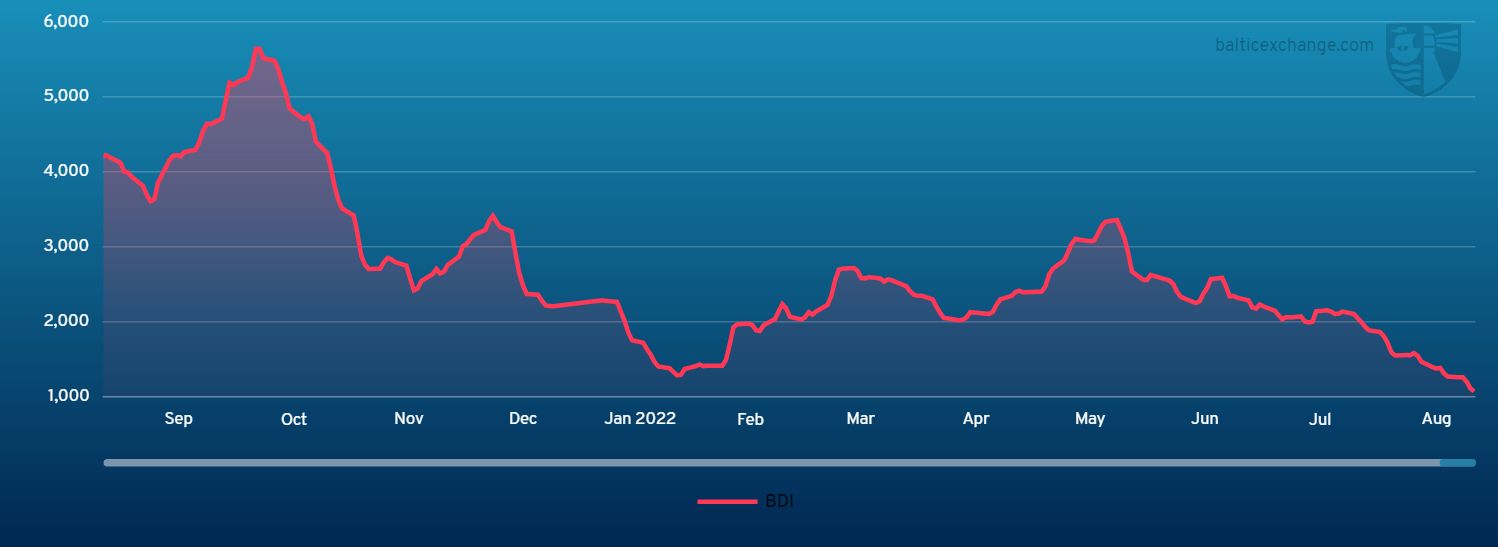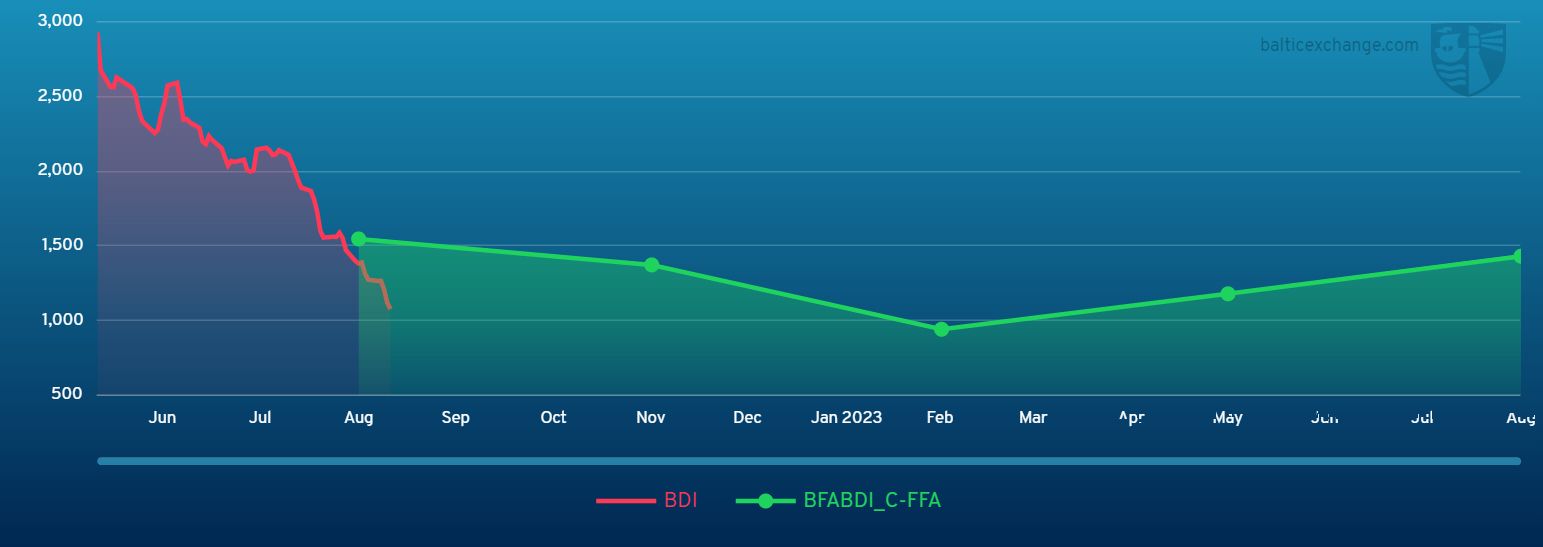BEIJING, Aug. 29 (Xinhua) -- The Baltic Exchange has published its weekly report of the dry and tanker markets for August 22-26, 2022 as below:
Capesize
The Capesize market is going through a rough period as trading pushed valuations into untenable sub-operating expense territory over the week. The Capesize 5TC dropped -$2,854 week on week to finish at $3,413. With rates so low and the outlook remaining poor, there is some speculation as to how far the sector will, and can, go. The Atlantic Basin has fallen dramatically from grace as the transatlantic C8 hovered at $3,111 as scrubber-fitted vessels were heard to be particularly aggressive in the region on the little cargo availability. In the Pacific, the West Australia to China C5 settled at $7.625 to end the week as iron ore demand from China continued to ebb. It remains to be seen what the upcoming week holds in store for the sector.
Panamax
The North Atlantic made a large correction over the week, with limited enquiry said to be an ongoing issue. An 82,000dwt was fixed from Las Palmas via North Coast South America to Singapore-Japan at around $19,000. An 80,000dwt, meanwhile, was rumoured to have been fixed for a trip from Gibraltar via North Coast South America to the Continent at around $8,000. East Coast South America also lacked impetus. An 84,000dwt fixing for early September delivery for a trip to Singapore-Japan at $16,400, plus a ballast bonus of $640,000. An 82,000dwt was fixed from Paranagua for a transatlantic run at $20,000. The Pacific also weakened. An 82,000dwt fixed from Ulsan for a North Pacific round at $16,000, whilst a 77,000dwt open in Nantong also fixed a similar trip at $11,000. There was limited fresh enquiry further south. A 75,000dwt fixing delivery Basuo via Indonesia redelivery North China at $18,000.
Ultramax/Supramax
It was mixed fortunes for the sector over the week. The general tone from the Atlantic remained slow, but the Asian arena did make gains in the first part of the week. However, as the week closed some felt the positive undertones were lacking. Period activity was seen and a 58,000dwt open Japan fixing 11/13 months trading redelivery worldwide at $18,000. From the Atlantic, it was limited activity from East Coast South America. However, a 55,000dwt fixed delivery Nouakchott trip via Santos redelivery Algeria at $20,500. Elsewhere, rates struggled. A 55,000dwt fixing a scrap run from the Continent to the East Mediterranean at $16,000. Asia remained relatively active in the south. A 64,000dwt fixed delivery Gresik for a trip via Kalimantan redelivery WC India at $28,000. Demand was patchy further north. A 56,000dwt fixed delivery Kunsan trip redelivery Mediterranean at $19,500. For transpacific business a 61,000dwt fixed delivery Japan via North Pacific redelivery South East Asia at $21,850.
Handysize
Negative sentiment dominated the sector as limited activity appeared across all regions. East Coast South America has seen rates drop further as fresh almost stalled for the remainder of August and early September. A 40,000dwt was fixed for a trip from Recalada to West Coast South America at $29,000 and 38,000dwt was fixed from Itaguai to Pecem with steels in the low $20,000s. Elsewhere, a 38,000dwt open in Boston was fixed via Venezuela to Turkey at around $15,000. A 35,000dwt open in the Baltic Sea was fixed from Finland to the Eastern Mediterranean at $13,000. There was limited action from Asia, but period interest remained. A 28,000dwt open in South China fixed for three to five months at $18,000 for August dates and a 28,000dwt open in CJK fixed for three to five months at $19,600 for early September delivery.
Clean
Clean Petroleum Product freight saw a resurgence in the Middle East Gulf. TC1 has jumped up 50 WS points to WS266.88 taking the TCE for the run up over $55,000 per day. Similarly, a run west on an LR2, TC20 has firmed up about $770,000 to just shy of $5,000,000. The LR1s also firmed with TC5 climbing 21.43 points to WS288.57. On a voyage to the UK-continent TC8 also hopped up to just over the $4,000,000 mark. On the MRs TC17 also saw increased momentum over the week and a spree of fixing leading the index to rise 56.67 points across the week and end up at WS399.17.
In the West the LR2s has seen improvements as in the Middle East. TC15 has added $145,000 bringing the index up to $3,837,500 by the end of the week. The LR1s of TC16 remained balanced. However, lesser market activity saw the index just dropping under the WS230 by the end of the week.
MRs on the UK-Continent had a little flurry of activity midweek. For both runs Transatlantic and down to West Africa which overall held rates stable in the region. TC2 dropped an incremental WS4.45 points to WS229.72 and TC19 only lost a touch over one point to WS237.5.
In the US-Gulf the MRs looked to have reached a floor for the moment with TC14 currently sitting as WS150 and TC18 resting at WS220.
The MR Atlantic Triangulation Basket TCE lost $1,569 from $22,947 to $21,387.
Handymax vessels, both in the Mediterranean and the Baltic, were chipped away again. Up in the Baltic TC9 lost 32.14 points to end up at WS467.86. In the Mediterranean the Cross-Med (TC6) suffered from enquiry remaining muted during the week, leading the index to be currently pegged at WS221.25 (-66.88).
VLCC
VLCC rates have remained flat over the week across all regions compared to a relatively volatile market previously. For 270,000mt Middle East Gulf/China, the rate through the week was flat with only a marginal rise after initially dropping at the front end to WS79.64 and ending up at WS80.64 (a round-trip TCE of $37,270 per day). Meanwhile, in the Atlantic, West Africa/China, the initial fall in rates to around WS80.09 recovered ever so slightly finishing at WS80.86.
Rates for 280,000mt Middle East Gulf/USG (via Cape of Good Hope) fell marginally by WS0.61 to WS45.72 (a round-trip TCE $2,647). 270,000mt USG/China fell from initial fixing at $9 million (a round-trip TCE of $30,519) to $8,931,250. But with reported fixtures between $9.3 and $8.7 million, level headedness prevailed to support midway levels.
Suezmax
The biggest mover by far was the 135,000mt Black Sea/Augusta market, rising just over WS18 points from an initial WS172.78 to WS188.72 (An increase of $10,540 per day TCE round trip; $64,555 to $75,095 per day).
This far outweighed the quieter Middle East Gulf/Med or West African/Continent markets which dipped both just over WS2 points from the start of the week. This dip has pushed TCE earnings for Middle East Gulf/Med into negative at -$1,650 per day.
Aframax
The Med Aframax market has begun moving upward with the rate for 80,000mt Ceyhan/West Mediterranean improving by WS8.87 to WS194.06 (a round-trip TCE of $44,474 per day). This is repeated in the North where 80,000mt Hound Point/UK Continent rose by nearly WS16 points and now sits at WS193.13 (a daily round-trip TCE of $53,482). Conversely, 100,00mt Primorsk/UK Continent fell by around WS11.5 points settling at WS209.69 (a round-trip TCE of $60,322 per day).
Across the Atlantic, the Caribbean market showed the greatest fall overall losing WS43.75 within the week, ending up at WS288.75 (a round-trip TCE earning of $59,337). But the rest of the US market wasn’t spared with 70,000mt USG/ARA shaving WS24.28 from the start of the week. An Aframax is now looking at WS235.36 (a round-trip TCE earning of $41,472 per day). The greatest loser overall happened to 70,000mt E.C Mexico/Houston tumbling WS65.93 points to settle at WS319.38 (a fall of $26,406 per day making TCE round-trip earnings $75,420).
Headquartered in London and a subsidiary of the Singapore Exchange (SGX), the Baltic Exchange publishes a range of indices and assessments which provide an accurate and independent benchmark of the cost of transporting commodities and goods by sea. These include the Baltic Dry Index (BDI), the dry bulk shipping industry's best known indicator. Published daily since 1985, this provides a snapshot of the daily spot market earnings of capesize, panamax and supramax vessel types on the world's key trading routes.

Chart shows Baltic Dry Index (BDI) during August 26, 2021 to August 26, 2022

Baltic Forward Assessment for BDI
In March 2018 the BDI was re-weighted and is published using the following ratios of time charter assessments: 40 percent capesize, 30 percent panamax and 30 percent supramax. The information is provided by a panel of international shipbrokers.
(Source: The Baltic Exchange, edited by Niu Huizhe with Xinhua Silk Road, niuhuizhe@xinhua.org)




 A single purchase
A single purchase









